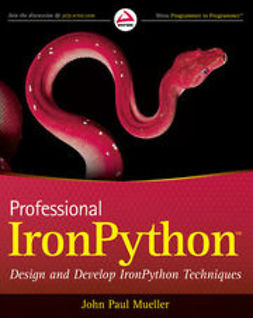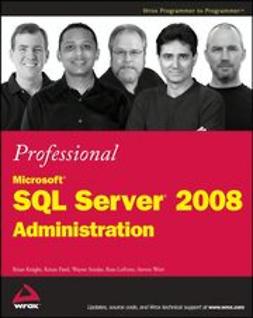Mueller, John Paul
Professional IronPython
- Part I: Introducing IronPython
This short part is designed to get the reader started using IronPython. It answers basic installation and usage questions, how to get help, and what makes IronPython different from other languages. The reader also discovers how to use familiar tools such as Visual Studio to work with IronPython and creates a very simple IronPython example. Most importantly, the reader becomes familiar with the IronPython environment and discovers how to use it.
- Part II: Using the IronPython Language
In this part, the reader learns the IronPython language. It assumes that the reader has worked with other programming languages and knows about basic programming constructs such as loops. This part is designed to get experienced developers up and running with IronPython quite quickly.
- Part III: Working with IronPython
Once the reader understand IronPython and it’s environment, it’s time to explore IronPython in actual use. IronPython can make use of the Python standard library and operate stand-alone or in concert with the .NET Framework, so this part explores both environments. In addition, the reader can use IronPython to create either desktop or Web-based applications, so this part shows both. Most readers will want to know how to interact with existing technologies such as the Component Object Model (COM) so there are areas that explore these needs as well. One interesting feature of this section is showing how to use IronPython to perform administration tasks. Microsoft is emphasizing the command line more in current products such as IIS and Exchange Server. In addition, Windows Server 2008 Server Core is nothing more than a command line environment, so this chapter plays to the current direction in Microsoft technology and gives this book a distinct advantage over the competition.
- Part IV: Advanced IronPython Topics
The reader of this book is advanced and wants advanced topics, so the bulk of the book concerns itself with topics that a knowledgeable reader will want. This section answers a wealth of interoperability questions, such as using IronPython from other .NET languages and working with external resources such as Web services. The reader will also discover techniques for extending IronPython and making it a more robust language. Finally, this part discusses two interesting topics: using IronPython to automate application testing and executing IronPython using Mono. This last topic is something you won’t find anywhere else and it’s doubtful anyone else will tackle it. This last chapter effectively extends IronPython into environments the reader may not have considered such as Windows Server 2008 Server Core (which lacks support for the .NET Framework) and Linux.
Keywords: how to use IronPython, how to program with IronPython, uses of IronPython, what is IronPython, what makes IronPython different, IronPython tools, how to install IronPython, IronPython installation, IronPython environment, using IronPython with the .NET Framework, creating desktop apps with IronPython, IronPython with Mono, IronPython with Windows Server 2008 server core, IronPython toolbox, how IronPython interacts with other technologies
- Author(s)
- Mueller, John Paul
- Publisher
- John Wiley and Sons, Inc.
- Publication year
- 2010
- Language
- en
- Edition
- 1
- Page amount
- 504 pages
- Category
- Information Technology, Telecommunications
- Format
- Ebook
- eISBN (ePUB)
- 9780470881668
- Printed ISBN
- 9780470548592






